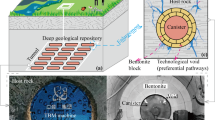The hydration of the shale is an important factors to the stability of borehole wall, and montmorillonite as the main component of the shale, its hydration inhibition mechanism is of great significance to maintain the stability of borehole wall of the shale. In this paper, molecular simulation software Material Studio is used to study the inhibition mechanism of potassium salt hydration inhibitors from a microscopic perspective. The results show that under the same conditions, montmorillonite has the smallest layer spacing, the largest diffusion coefficient, the smallest coordination number and the best inhibitory effect. On the whole, the parameters of potassium nitrate are significantly higher than potassium silicate and potassium carbonate; Hydration degree is low, potassium chloride inhibitor on the mechanical parameters of montmorillonite increase degree is one of the biggest, followed by potassium nitrate, potassium carbonate and potassium silicate; The effect of potassium formate on the mechanical strength of montmorillonite was similar to that of potassium chloride at higher hydration degree. Therefore, different hydration inhibitors should be selected for different hydration degrees.


Similar content being viewed by others
References
J. Xu, T. Gu, W. Shen, X. Wang, Y. Ma, L. Peng, X. Li, “Molecular simulation and experimental study on the effect of inorganic salts on elastic parameters of Montmorillonite,” Journal of China University of Petroleum (Edition of Natural Science)., 40, No.40, 83-90 (2016).
N. T. Skipper, F. Chou, G. Sposito, “Monte Carlo simulation of interlayer molecular structure in swelling clay minerals. 1. Methodology,” Clays and Clay Minerals., 43, No.3, 285-293 (1995).
G. Jiang, J. Wang, Y. Xuan, “Performance and Functional Mechanism of Potassium Methylsiliconate as Shale Inhibitor,” Science Technology and Engineering., No. 8, 6-10 (2014).
X. Huang, J. Xu, T. Ding, X. Li, L. Li, “Molecular simulation on the inhibition mechanism of organic amine to montmorillonite hydration,” Oil Drilling & Production Technology., No.4, 442-448 (2017).
W. Loewenstein, “The distribution of aluminum in the tetrahedra of silicates and aluminates,” American Mineralogist., 39, No.12, 92-96 (1954).
N. T. Skipper, F. Chang, “Monte Carlo simulation of interlayer molecular structure in swelling clay minerals.2. Monolayer hydrates,” Clays and Clay Minerals., 43, No.3, 294-303 (1995).
R. Sun, Y. Zhang, K. Fan, Y. Shi, S. Yang, “Molecular simulations of adsorption characteristics of clay minerals in shale,” CIESC Journal., 66, No.6, 2118-2112 (2015).
X. Li, “Molecular simulation of inhibition mechanism of typical shale inhibitors on montmorillonite hydration,” China University of Petroleum., (2016).
R. T. Cygan, J. Liang, A. G. Kalinichey, “Molecular models of hydroxide, oxyhydroxide, and clay phases and the development of a general force field,” The Journal of Physical Chemistry. B., 108, No.4, 1255-1266 (2004).
A. A. Samoletov, C. P. Dettmann, M. A. Chaplain, “Thermostats for “slow” configurational modes,” Journal of Statistical Physics., 128, No.6, 1321-1336 (2007).
D. Frenkel, B. Smit, “Understanding molecular simulation: from algorithms to applications,” Elsevier., (2001).
W. VOIGT, “Ueber die Beziehung zwischen den beiden elasticitatsconstanten isotroper Korper,” Annalen der Phys., 274, No.12, 573-587 (1889).
A. REUSS, “Berechnung der fließgrenze von mischkristallen auf grund der plastizitatsbedingung fur einkristalle,” ZAMM-J Appl Math Mech., 9, No.1, 49-58 (1929).
R. Hill, “The elastic behaviour of a crystalline aggregate,” Proceedings of the Physical Society. Section A., 65, No.5, 349-354 (1952).
Y. Zhang, M. Chen, Y. Deng, Y. Jin, “Molecular Dynamics Simulation of Temperature and Pressure Effects on Hydration Characteristics of Montmorillonites,” Journal of the Chinese Ceramic Society., No.10, 1489-1498 (2018).
Acknowledgments
This work is supported by Science and Technology Cooperation Project of the China National Petroleum Corporation-Southwest Petroleum University (CNPC-SWPU) Innovation Alliance (No.2020CX040201).
Author information
Authors and Affiliations
Corresponding author
Additional information
Translated from Khimiya i Tekhnologiya Topliv i Masel, No. 2, pp. 94–97 March– April, 2022.
Rights and permissions
About this article
Cite this article
Zhang, A., Su, J. & Li, L. Molecular Simulation of Hydration Characteristics of Montmorillonite under Potassium Salt Inhibitor. Chem Technol Fuels Oils 58, 403–409 (2022). https://doi.org/10.1007/s10553-022-01397-1
Published:
Issue Date:
DOI: https://doi.org/10.1007/s10553-022-01397-1




